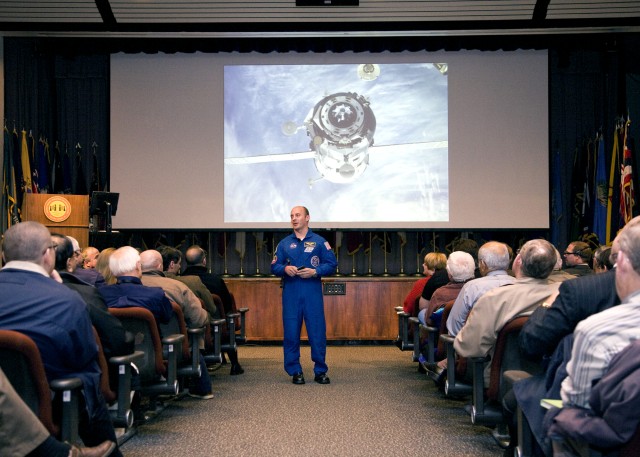
PICATINNY ARSENAL, N.J. - Picatinny employees welcomed a local American icon to the installation for what some might refer to as story time Oct. 30.
Dr. Garrett E. Reisman can lay claim to something other people might have only dreamed about as children. Reisman, a NASA astronaut, recently returned from space.
Reisman logged more than three months in space and completed a seven-hour space walk, which is also known as an extra-vehicular activity.
The seven-man crew lifted off on the space shuttle Endeavour March 11 and returned to Earth via the space shuttle Discovery on June 14. Reisman told the group that he has the distinction of being the first Jewish crewmember on the International Space Station, where he saw the comings and goings of astronauts from several different countries while aboard.
Reisman then gave members of the Picatinny workforce an hour-and-a-half presentation that included a 10-minute video of his experiences, which he referred to as his "summer vacation."
Reisman is no stranger to the Picatinny community. The Morristown native's late father, Robert A. Reisman, worked here for more than 30 years.
In fact, one of Picatinny's most prominent landmarks, the Robert A. Reisman Precision Armaments Laboratory tower, was dedicated in memory of the former Picatinny engineer and chief of precision munitions, who championed the advancements in military "smart" munitions throughout his career. The 215-foot tower provides engineers with the capability of testing sensors in adverse weather conditions while experimenting with reaction to freefall from various heights.
"Bob liked to always stand above his peers," said Dr. Joseph A. Lannon, director of the Armament Research, Development and Engineering Center, referring to the laboratory tower's prominence. "And he does, as he is a legendary figure in our history."
The elder Reisman was known to be an entertaining speaker, and the younger Reisman lived up to his legacy as Picatinnyans sat in awe listening to the comical trials of the life of an astronaut.
Reisman said that one of his tasks while aboard the space station was to assemble a giant fiction-like robot called Dextre, which is part of Canada's contribution to the ISS.
Dextre is a multi-armed robot with special grippers, cameras and lights attached to its hands. Dextre's mission is to install and replace the station's battery packs. The astronauts can control Dextre's arms with a control system located inside the space station.
The crew assembled Dextre on the space station, something Reisman said was "kind of like putting a Christmas present together."
In preparation of assembling the robot, the astronauts practiced putting Dextre together in a swimming pool as part of their training before the mission, he said.
Reisman also described day-to-day routines, such as exercise to help defeat the decrease in bone density, playing with their food (because with zero gravity, everything floats, he said), and using a special scale that oscillates up and down so physicians can effectively track the astronauts' body weights.
"It is very important to workout while in space," Reisman said. "There is tremendous atrophy in your hips and ankles."
The shuttle had modified exercise bikes and treadmills that allowed the users to strap themselves in to allow them to workout without defying gravity.
As for the view, Reisman explained that it takes about an hour-and-a-half for the shuttle to rotate around the earth. He described being able to look out a nearby window while exercising and jokingly said, "I ran across the Pacific Ocean in just minutes."
Before Reisman's journey began in March, Brig. Gen. William N. Phillips, Picatinny Arsenal commanding general, gave Reisman several Picatinny artifacts to take into space. Reisman promised to do so and he lived up to his promise. The astronaut returned them to Lannon during the presentation, with photos which he called "certificates of authentication."
Dr. Reisman's visit was sponsored by the local chapters of the American Institute of Aeronautics and Astronautics, Association of the United States Army and National Defense Industrial Association.

Social Sharing